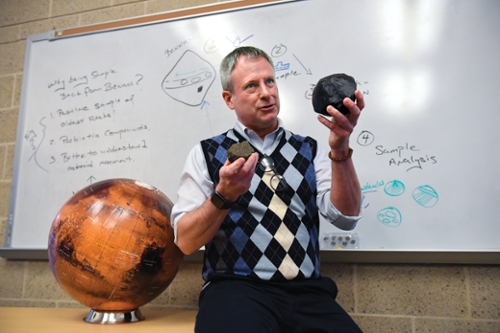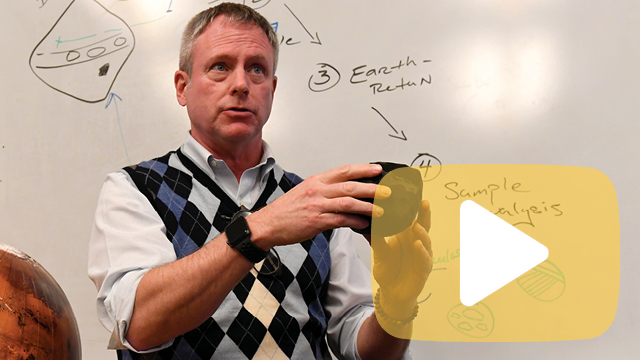Rowan geology prof to study OSIRIS-REx asteroid sample
Rowan geology prof to study OSIRIS-REx asteroid sample

More than a decade of planning and countless computations came to fruition Oct. 20 when, after a journey of some two billion miles, the NASA spacecraft OSIRIS-REx dropped a robotic arm, expelled a burst of nitrogen to loosen the surface, and completed a touch-and-go collection maneuver above the asteroid Bennu.
Launched in 2016, the vessel’s historic mission is to capture up to four pounds of carbonaceous space rock from a moving asteroid 200 million miles from Earth in a real-life movie narrative that scientists believe could help resolve some of humankind’s oldest, most pressing questions.
By studying the space debris returned by OSIRIS-REx, scientists will plumb clues into how planet Earth formed in the first place, why it contains vast amounts of carbon and water, two necessary components of life, and whether we will one day be able to alter the path of large asteroids like Bennu that could potentially hit Earth.
Rowan University’s Dr. Harold Connolly Jr., founding chair of the Department of Geology in the School of Earth & Environment, will help lead research into the spacecraft’s payload when it returns in 2023.
Ebullient after viewing the spacecraft’s descent and TAG maneuver, Connolly, who holds the title of Mission Sample Scientist with the OSIRIS-REx mission, returned to the classroom the next morning to share his excitement with students and explain what the world witnessed.
“Perhaps the biggest question in all philosophy or science is the origin of life, but you can’t have life as we know it until a planetary body is formed,” Connolly told students in his 8 a.m. Mineralogy and Petrology class.
Noting that OSIRIS-REx samples will help scientists better understand the formation of Earth-like planets, he said while scientists have long studied meteorites (space material that reaches Earth), their passage through the atmosphere changes them so they cannot begin to reveal all that samples captured directly from an asteroid could.
“We still don’t know how planets are made,” he said. “By returning a sample from an asteroid, we’ll have pristine data points.”
Already publishing, and highly honored
Connolly and the OSIRIS-REx team have already published widely on a range of studies related to the satellite’s mission. Connolly, who is also a co-investigator on the Japanese space agency JAXA’s Hayabusa2 mission to the asteroid Ryugu, has co-authored numerous articles for science journals including “Bennu’s near-Earth lifetime of 1.75 million years inferred from craters on its boulders,” which ran in the Oct. 26 issue of Nature.
On March 19, 2019, the OSIRIS-REx team published “The unexpected surface of asteroid (101955) Bennu,” which described a rougher, rockier exterior than expected, which was documented by the spacecraft in tens of thousands of black and white images collected after entering Bennu’s orbit.
Connolly, who in addition to his full professorship and Geology chair with Rowan, was a visiting Professor of Natural Sciences at Hokkaido University in Sapporo, Japan in 2015. He’s a recipient of the U.S. Antarctic Service Medal from the U.S. Department of the Navy, a fellow of the Meteoritical Society, and was recently appointed to the Planetary Science and Astrobiology Decadal Survey 2023-2032: Panel on Small Solar System Bodies by the National Academies of Science, Engineering and Medicine.
TAG maneuver a success!
While it wasn’t immediately clear to viewers how much material the satellite collected, or even if it did, the crucial TAG maneuver was in fact a success, Connolly said.
He said the maneuver appeared to go flawlessly as the spacecraft descended in near real time, discharged a blast of liquid nitrogen and appeared to collect its sample.
“Gas is also a fluid. It fluidizes the loose materials on the surface and we pick it up,” he told the class.
During the broadcast by NASA, OSIRIS-REx personnel said Bennu was chosen out of hundreds of thousands of known asteroids, partly for smooth, sandy conditions they expected to find on its surface.
It wasn’t until the spacecraft reached its orbit in 2018 and scientists began photographing its surface that they learned it was not smooth and sandy but jagged and rocky, and those conditions forced a collection attempt in a spot called Nightingale that was the size of a few parking spaces.
Known to scientists as an “active asteroid,” Bennu resembles a spinning, deep space charcoal briquette that releases particles as it turns. And, like a charcoal briquette, the sample returned to Earth will be crumbly, Connolly said.
“The trip home will be pretty static but when the Sample Return Capsule comes through the Earth’s atmosphere it will really start to shake,” he said. “The sample could break into smaller particles.”
Like many in the class, senior geology major Mallory Osmun said she was thrilled to have witnessed history the night before, and she was ecstatic for her professor.
“I literally almost cried,” she said. “It was such a relief. I was so happy for Dr. Connolly and for everyone involved.”